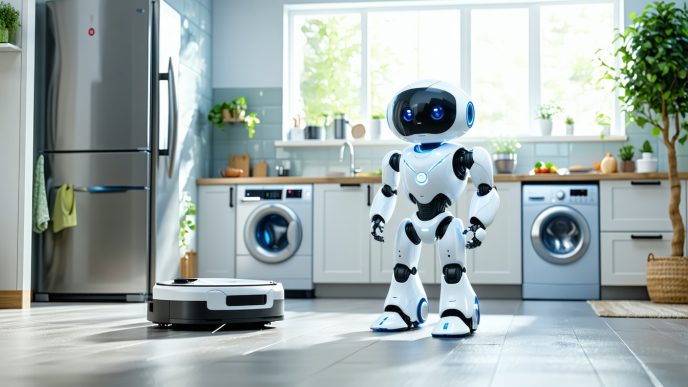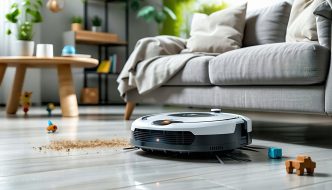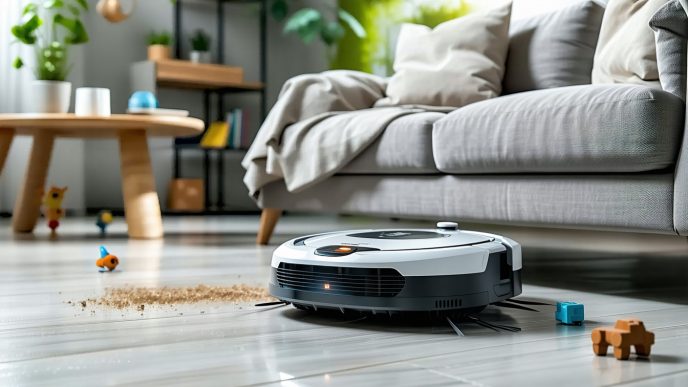Evolution of Household Robotics
Introduction to Robotics in Household Tasks
The integration of robotics into everyday household tasks has evolved significantly over the years. Initially, automation was limited to simple devices designed for specific purposes. However, advancements in technology have led to the development of versatile robots that assist with a variety of outdoor tasks. Homeowners, busy professionals, and families are increasingly turning to these solutions to alleviate the burden of manual labor and enhance their living environments.
Robots designed for gardening and yard work are gaining traction. They provide convenient solutions for tasks ranging from lawn maintenance to garden care. These devices not only save time but also ensure a higher level of precision in outdoor chores. The acceptance and use of these household robots are part of a broader trend toward automation in daily life. For more on how different robots can help, refer to our article on household task robots.
Advancements in Automation Technology
Recent advancements in automation technology have been pivotal in the evolution of household robotics. Key areas of development include:
- Artificial Intelligence: Enhanced AI allows robots to learn from their environment and adapt to changes, improving their efficiency over time.
- Sensors and Cameras: The deployment of advanced sensors enables robots to navigate complex outdoor spaces. High-definition cameras assist in mapping areas and executing tasks with precision.
- Connectivity: Many household robots now feature smart connectivity, allowing integration with other smart home devices. This connectivity allows for synchronized task management and improved user control.
- Battery Efficiency: Modern robots utilize advanced battery technology that provides longer runtime and quicker charging, enhancing their usability for outdoor tasks.
| Advancement | Description | Impact on Homeowners |
|---|---|---|
| Artificial Intelligence | Learns and adapts to surroundings | Improved efficiency and task execution |
| Sensors and Cameras | Navigate and map environments | Precision in outdoor chores |
| Connectivity | Integration with smart devices | Simplifies task scheduling and control |
| Battery Efficiency | Longer runtime and quicker charging | Increased usability and convenience |
The future of outdoor household automation hinges on these advancements. As technology continues to develop, the potential for robots to enhance everyday tasks grows significantly. For a look at future innovations, explore our article on future of household automation. Through these advancements, robots are set to revolutionize outdoor maintenance, making it easier for homeowners to manage their properties.
Robotic Lawnmowers
Robotic lawnmowers are transforming the way homeowners manage their outdoor spaces. These innovative devices automate the task of mowing lawns, allowing families and busy professionals to save time and effort while maintaining a neat yard.
How Robotic Lawnmowers Operate
Robotic lawnmowers function with advanced technology, utilizing sensors, GPS, and cutting blades to navigate and trim grass efficiently. They operate much like a robotic vacuum cleaner but are specifically designed for outdoor environments. Typical operational features include:
- Sensors: Robotic lawnmowers are equipped with obstacle sensors that help them detect and avoid objects like trees, garden furniture, and pets.
- Boundary Wires: Most models come with boundary wires that define the area to be mowed, ensuring the machine remains within a designated perimeter.
- Cutting Patterns: These devices often feature different cutting patterns, allowing the mower to cover the lawn in a systematic manner.
- Scheduling: Users can program mowing schedules via a control panel or companion app, effectively managing the mowing frequency. See more about scheduling tasks for household robots for better efficiency.
Here’s a table illustrating key operational features of robotic lawnmowers:
| Feature | Description |
|---|---|
| Navigation | Uses sensors and GPS for safe movement |
| Cutting Mechanism | Typically utilizes rotating blades |
| Boundary Definition | Boundary wires to limit mowing area |
| Scheduling Capabilities | Options to set preferred mowing times |
Benefits of Robotic Lawnmowers
Robotic lawnmowers provide numerous benefits that enhance outdoor household management:
- Time Savings: They can operate autonomously, freeing up personal time for homeowners to focus on other activities.
- Consistent Lawn Care: Regular mowing leads to healthier grass and a well-maintained appearance.
- Energy Efficiency: Many robotic lawnmowers are designed to be eco-friendly, often utilizing rechargeable batteries.
- Reduced Physical Strain: These machines eliminate the need for manual mowing, lowering the risk of physical strain or injury.
Here’s a table outlining the benefits of robotic lawnmowers:
| Benefit | Description |
|---|---|
| Time Efficiency | Automatic mowing allows for multitasking |
| Consistent Results | Regular cuts promote healthy grass growth |
| Eco-Friendly Operation | Many models use electric power sources |
| Reduced Labor | Less physical effort required for lawn maintenance |
Robotic lawnmowers are a prime example of how household task robots can significantly enhance the quality of life for homeowners. By automating lawn care, these devices allow families and professionals to enjoy their outdoor spaces without the burden of chores. For more insights into robotics in household tasks, explore other applications like robots for cleaning floors and robots for dishwashing and kitchen cleaning.
Robot Window Cleaners
Window cleaning can be a time-consuming chore, often requiring ladders and specialized tools to reach difficult areas. Robot window cleaners have emerged as innovative solutions that automate this task, providing homeowners with a simple way to keep their windows sparkling clean.
How Robot Window Cleaners Work
Robot window cleaners operate using a combination of advanced technologies such as suction, sensors, and cleaning pads. These robots typically feature the following mechanisms:
- Suction Mechanism: This enables the robot to adhere to the window surface, allowing it to navigate vertically.
- Navigation Sensors: Equipped with sensors, these robots can detect edges and obstacles, allowing them to adjust their movement accordingly.
- Cleaning Pads: The robots use microfiber or other specialized pads to effectively scrub and dry the glass surfaces.
The typical operational process starts when the user places the robot on the window. Once activated, it will systematically clean the glass, moving in a pre-determined pattern to ensure thorough coverage. Some models can be controlled via smartphone apps, adding convenience to the cleaning process.
| Feature | Description |
|---|---|
| Power Source | Rechargeable batteries |
| Cleaning Method | Automated scrubbing and drying |
| Control Options | Manual operation or app-based control |
| Surface Compatibility | Vertical windows, glass doors, and balconies |
Advantages of Robot Window Cleaners
Robot window cleaners offer various benefits that appeal to families, homeowners, busy professionals, and tech adopters. Some of the primary advantages include:
- Time-Saving: By automating window cleaning, these robots free up valuable time for individuals with busy schedules.
- Safety: Eliminating the need for ladders reduces the risk of accidents while cleaning high or hard-to-reach windows.
- Consistent Performance: These robots can deliver uniform cleaning results, ensuring that windows remain streak-free.
- User-Friendly: Many models come with simple controls, allowing users to start the cleaning process quickly without needing expertise.
Incorporating robot window cleaners into household routines can significantly enhance the efficiency of maintaining clean windows. They fit neatly into the broader category of household task robots, contributing to everyday convenience alongside other automation devices such as robots for cleaning floors and robots for laundry assistance.
Automated Pool Cleaners
Automated pool cleaners have revolutionized how homeowners maintain their pools. These devices operate autonomously, ensuring that pools remain clean and inviting with minimal human intervention.
Functionality of Automated Pool Cleaners
Automated pool cleaners utilize advanced technology to move around the pool and remove debris. They typically feature sensors that help them navigate obstacles and determine the most efficient cleaning path. Depending on the model, they can be powered by electricity, batteries, or solar energy.
Most automated pool cleaners fall into three categories: suction-side, pressure-side, and robotic cleaners. Each type works differently to ensure a thorough clean:
| Type | Functionality |
|---|---|
| Suction-side | Connects to the pool’s filtration system to vacuum dirt and debris. |
| Pressure-side | Uses pressure from the pool’s water return system to propel itself and collect debris. |
| Robotic cleaners | Operate independently, with onboard filtration systems and smart programming for efficient cleaning. |
The cleaning cycles can be programmed, allowing users to set a schedule for when the cleaner operates. This feature can be particularly beneficial for busy families or professionals. For more on scheduling tasks for household robots, visit our article on scheduling tasks for household robots.
Benefits of Using Automated Pool Cleaners
The adoption of automated pool cleaners brings numerous advantages for homeowners:
| Benefit | Description |
|---|---|
| Time-saving | Reduces manual cleaning time, allowing for more leisure time. |
| Consistent cleaning | Ensures regular upkeep of pool cleanliness. |
| Reduced chemical usage | Efficient debris removal can minimize the need for chemical treatments. |
| Cost-effective | Lowers maintenance costs and can extend the lifespan of pool equipment. |
| Easy operation | Simple setup and usage, making it accessible for all skill levels. |
Automated pool cleaners not only save time but also enhance the overall enjoyment of pool ownership without the constant effort of manual cleaning. For more information on household task robots, check our article on household task robots. As the technology behind robotics continues to advance, the future of household automation looks promising. For insights on upcoming innovations, explore our article on the future of household automation.
Robot Weeders and Planters
In the realm of gardening and yard work, robot weeders and planters are becoming invaluable tools for families and professionals alike. These machines streamline the tasks of weeding and planting, allowing for more efficient garden maintenance.
Mechanisms of Robot Weeders and Planters
Robot weeders are designed to identify and remove weeds using various advanced technologies. Equipped with sensors and cameras, they can differentiate between crops and unwanted plants. The typical operational process involves:
- Mapping the Garden: Utilizing GPS and visual recognition, these robots create a layout of the garden to understand where weeds and plants are located.
- Weed Identification: Advanced algorithms analyze the visual feed to recognize weed species.
- Removal Method: Depending on the model, weed removal can be accomplished through mechanical tools, such as cutting blades or specialized claws, or by applying targeted herbicides.
Robot planters function similarly, but their main focus is on efficiently planting seeds at the right depth and spacing. Key features include:
- Seed Dispensing: Robots are designed with compartments that hold seeds and release them at controlled intervals.
- Soil Preparation: Many units can till the soil before planting, ensuring that seeds have optimal conditions for growth.
- Precision Planting: These machines ensure accurate placement, which aids in maximizing space and promotes healthier plant growth.
| Functionality | Robot Weeders | Robot Planters |
|---|---|---|
| Identification Method | Sensors and cameras | GPS and visual recognition |
| Weed Removal Technique | Mechanical or chemical | Seed dispensing |
| Soil Preparation | Not applicable | Tilling capabilities |
Advantages of Robot Weeders and Planters
Integrating robots into gardening tasks presents numerous advantages that appeal to homeowners and busy professionals. Key benefits include:
- Time Savings: By automating weeding and planting, individuals can focus on other important tasks, which is particularly beneficial for those with tight schedules.
- Precision: Robot weeders and planters provide accurate placement and removal, leading to healthier gardens and reduced waste.
- Labor Reduction: These machines minimize the physical effort required for manual weeding and planting, reducing strain on users.
- Environmentally Friendly Options: Many robot weeders utilize organic or selective herbicides, promoting sustainable gardening practices.
- Improved Crop Yield: With precise planting techniques, overall plant health and growth rates can improve, leading to better yields for vegetable and flower gardens.
The use of robots for gardening and yard work is revolutionizing how homeowners and professionals manage their outdoor spaces, making gardening tasks more manageable and efficient. By implementing these robotic solutions, individuals can enhance their gardening experience while embracing modern technology. For more insights into household automation, check our article on future of household automation.
Future Trends in Household Robotics
As technology continues to advance, the future of household robotics looks promising, especially in the realm of outdoor tasks. Innovations are on the horizon that will further transform how families and homeowners manage gardening and yard work.
Potential Innovations on the Horizon
Emerging technologies are set to enhance the capabilities of robots used for gardening and yard work. Some of the anticipated innovations include:
| Innovation | Description |
|---|---|
| Improved AI | Enhanced artificial intelligence for better decision-making in gardening tasks. This includes understanding plant health and environmental conditions. |
| Advanced Sensors | Robots equipped with sophisticated sensors to detect weeds, pests, and soil quality, allowing for more efficient gardening practices. |
| Solar Power | Increased reliance on solar power sources to extend the operational time of outdoor robots without adding to electricity costs. |
| Integrated Systems | Robots capable of working together with other home automation systems for synchronized yard maintenance and monitoring. |
Impact of Robotics on Outdoor Household Tasks
The growing presence of robots in outdoor household tasks is expected to significantly alleviate the workload for busy professionals and families. Key impacts include:
-
Time Savings: Automating gardening activities allows homeowners to focus on other activities, such as spending quality time with family or pursuing hobbies.
-
Consistency in Care: Robotic systems provide consistent and routine maintenance, leading to healthier plants and well-kept yards.
-
Reduced Labor Costs: Using robots for yard work reduces the need for hired help, leading to cost savings over time.
-
Sustainability: Robotics can promote eco-friendly practices by employing methods that minimize waste and use resources efficiently, contributing to a healthier environment.
Families and homeowners stand to benefit significantly from the evolving landscape of household task robots, especially as features become more innovative and integrated into daily living. As robotics progresses, it will play an increasingly vital role in simplifying outdoor tasks, thus enhancing daily living experiences and fostering more sustainable practices. For more insights into the future of automation, explore our article on future of household automation.















